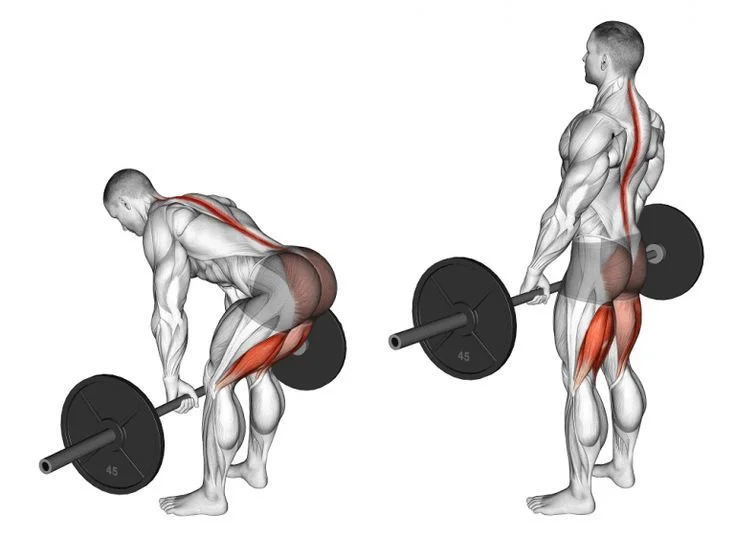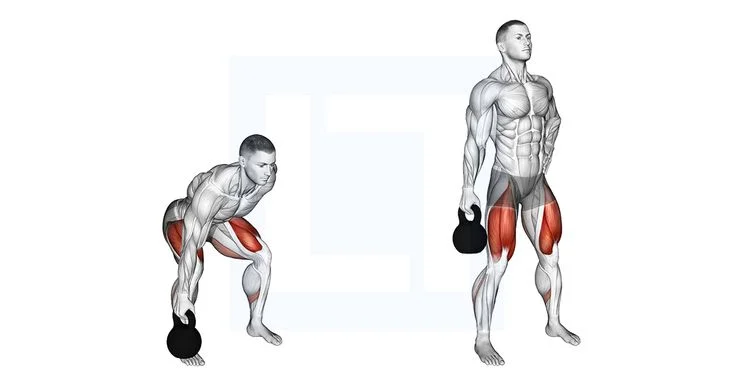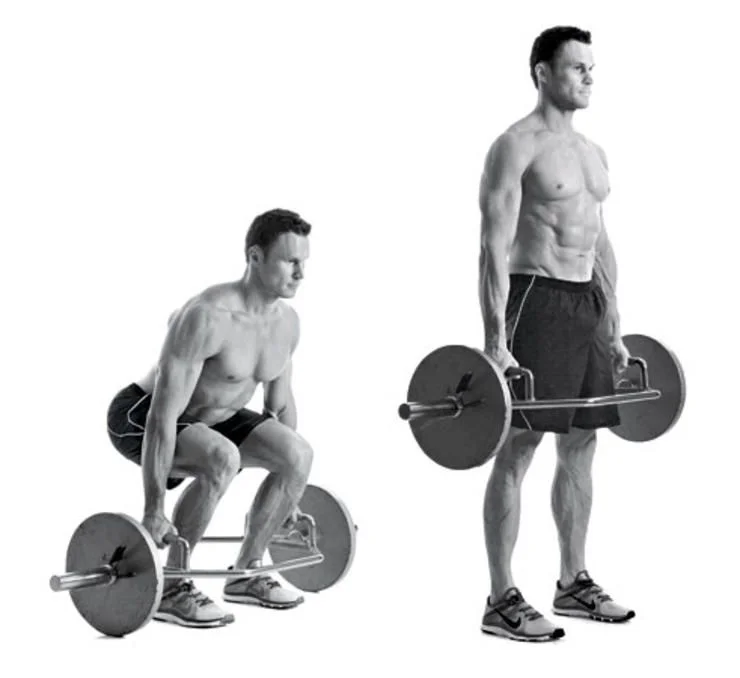The deadlift Workout is a fantastic method for developing powerful butt and legs. With the help of most of your body’s big muscle groups, you use your leg and hip muscles to predominantly transfer the weight from the ground to your thighs during a deadlift. Although dumbbells can also be used, the deadlift is typically executed with a stationary barbell or bar and plates. You shouldn’t disregard powerlifters’ specialty when doing weight training for overall fitness. Include the deadlift in your strength training regimen to increase your muscle mass and functional fitness.
How to Do a Deadlift Workout
8 Key Techniques Deadlift form

- Place the toes under the bar and place the feet shoulder-width apart, or slightly wider. The feet might be angled slightly outward or straight in front. On the ground, heels ought to remain level. The bar will come into contact with your shins when you raise it, maybe grazing them. Retain a neutral lumbar posture.
- Brace the abdominal muscles to stabilize them.
- Drop to a squat, bending your knees. While not the same as a squat, the form for going down to the bar is comparable in that it requires a straight or slightly arched back rather than a rounded spine or shoulders.
- Use an overhand or mixed grip to hold the bar just outside of your knees.
- Raise the bar by using your legs to push upward from the knees. Upon exertion, exhale. Take caution not to lift your hips before your trunk so that your back becomes rounded. Avoid attempting to raise the bar with your arms. As the legs push up, the arms remain extended and tensely hold the bar. Imagine the hips, the center of balance, moving up in tandem with the shoulders and legs.
- As you achieve your maximum height, the bar should almost touch your shins before resting at thigh level. Without leaning over, as much as you can, pull your shoulders back.
- To guarantee a straight back, lower the bar to the floor in the opposite direction.
- Continue until you reach the required amount of reps.
what are the benefits of deadlifting?
The hamstrings (back of the leg), quadriceps (front of the thigh), gluteals (butt), and erector spinae (lower back) muscles are used during the deadlift. Additionally involved are the stabilizer muscles found in the upper back, shoulders, abs, and core.
Increases Muscle Mass
Bodybuilders and those seeking to stop or reverse muscle loss due to age find deadlifts to be an excellent way to gain muscle mass. The deadlift workout is a useful exercise for increasing stability, core strength, and general strength.
Increases Metabolism
How many calories you burn when at rest depends on your metabolism. Your metabolism increases with lean muscle. You can assist in speeding up your metabolism by gaining more lean muscle in your body. Deadlifts are an excellent option for increasing the proportion of lean muscle in your body since they engage some of the biggest muscle groups in the body.
improve Occupational Health
The deadlift workout is a functional workout since it is one of the finest ways to simulate the lifting you undertake in your daily life. You can lift and carry things more safely in daily life if you can deadlift with proper form.
Variations of Deadlift Exercise
There are various ways to perform the deadlift workout depending on your fitness level and goals. With different leg and grip locations, there are several advanced versions imaginable.
Like with any exercise, you should only lift little weights or even just a bar without any extra weight when you are first starting with the deadlift. Have a trainer guide you and provide form critiques. When you are doing it well, you start to raise the weight.
Deadlifts with dumbbells

You might try a kettlebell or vertical dumbbell deadlift workout with a lower weight if you don’t have access to a barbell or if the weight of the bar is too difficult for you. Like with a barbell, you grab the object with both hands and pivot at the hip to raise it. As an alternative, you can perform a range of full-body workouts, such as deadlifts, with workout sandbags.
Romanian Deadlifts

The primary distinction between Romanian deadlifts and standard deadlifts is that the former begins the lift from a standing posture, while the latter does so from a squat. The posterior chain muscles, which include the muscles that run along the back of your body and include the glutes, hamstrings, and calves, are worked in this variation. The Romanian deadlift workout, which more closely resembles real-life scenarios involving the lifting and movement of large things, can also be performed with offset feet.
Stiff Leg Deadlift

With this variation of the deadlift, you stay upright the entire time, maintaining a straight spine and nearly locked knees. As you bend forward and stand back up, keep the bar close to your body and maintain a neutral spine. Compared to regular or Romanian deadlifts, the stiff leg deadlift engages the gluteus maximus and hamstrings more.
Kettlebell Suitcase Deadlift

This variation requires lifting weight on one side of the body at a time, using only one hand. Imagine the movement of picking up a suitcase. It is excellent for strengthening your core, as you engage those muscles to prevent your body from leaning over to the side with the weight.4 This movement requires bending as if to squat, as in a standard deadlift, rather than keeping straight legs.
Trap bar deadlift

Because of the hexagonal form of the bar that’s utilized, this variant is sometimes called the “hex bar deadlift.” This is an incredibly efficient variation of the deadlift because the trap bar handles are positioned side-on, which forces you to contract your lats and retract your shoulder blades. Because you won’t be dragged forward, it’s excellent for quickly building strength and doesn’t strain your lower back like other deadlift variations do.
Change Your Grip
The potential grip types are as follows:
- Both hands are held palm down in the conventional overhand grip. The overhand grip is demonstrated if the backs of both hands are visible. This grip works well with smaller weights.
- With a mixed grip, one hand grasps the bar with its palm pronated (over the bar) and the other with its palm supinated (under the bar). Using a combined overhand-underhand grip is recommended for larger loads. There is some comfort in knowing that larger weights won’t fall out of the hands when using this grip.
On the bar, the grip can be either wider or narrower. Arms straight down with a grip perpendicular to the shoulder joint are common beginning positions. For others, a little broader grip could be more comfortable, and a wide-grip deadlift is a legitimate variant. The regular grip is better suited for heavier lifts since it uses the quadriceps instead of the hips and back like the wide grip does.
Common Mistakes
Although deadlifts offer several advantages, proper technique is essential. It’s not worth taking a chance if you get injured from deadlifts because you might not be able to work out until you heal. Steer clear of these mistakes to maximize the benefits of this workout with minimal chance of strain or damage.
Rounding Your Back or Shoulders
Maintain a straight back, without hunching over at the shoulders or vertebrae. It is proper to hang from the hips. Butt out and keep those hips down. To support your straight back, brace your abs.
Lifting With Your Arms or Back
Although their stabilizing role is crucial, the key to lifting for novices is to use the legs and hips rather than the arms, shoulders, or back. As you lift, maintain a straight arm position. Bicep strain can occur when you bend your arms.
Using Too Much Weight
Start with a lightweight and work your way up to a satisfactory form. A gym or personal trainer can confirm that you are using the proper form. If needed, practice in front of a mirror. As your fitness level rises, you can add weight, but it’s best to start slowly to avoid overstretching your muscles. The same goes for weightlifting exercises: appropriate footwear is crucial. Check out these top CrossFit sneakers.
Partial Lifts
You can perform repetitions with a lightweight by lowering the bar to your shin or even the floor, then straightening without letting go of the bar. This isn’t a repetition of a deadlift workout. It is preferable to practice a full lift, descend to the ground, and then stand back up.
Bar Too Far From Body
When performing deadlifts, people occasionally place the weight too far away from their bodies. For best lift efficiency and safety, the bar should travel near the body. Skimming the front of your legs is acceptable when lifting.
Safety and Precautions
A challenging weightlifting exercise is the deadlift workout. If you have any ailments or injuries that impact your back, shoulders, wrists, legs, knees, ankles, hips, or torso, consult a healthcare professional to determine whether it’s the right course of action for you. Make sure you get the right coaching for the right method. Start with light weights and quit if you experience any pain. It is recommended to utilize smaller weights and to adopt the wider sumo stance when pregnant. For more support, women can think about donning a high-neck sports bra.
deadlift workout routine
To avoid overstressing your back, you should complete these exercises once a week if you’re new to deadlifting.
You should work out twice a week to get a tough workout that will improve your deadlift. The objective is to have one heavy set and one volume set per week, though you can mix and match. (First-timers will experience one heavy and one high rep week.)
If you’re serious about getting better, you ought to try lifting more weight at the bar once a week. Don’t be scared to put on the smallest plates in the gym and hoist that bar; they are still adding weight.
Workout A (Volume)
- 2 x 12 warmup sets (20-30% of max)
- 5 x 12 deadlift (50% of max)
- 1 x 15 deadlift (60 % of max)
3 x 10 Romanian deadlift (40% of max) – Ensure you have good form and drop the weight if needed
Workout B (Weight)
- 1 x 10 warmup set (30-40% of max)
- 3 x 6 deadlift (70-75% of max)
- 2 x 5 deadlift (80% of max)
- 2 x 2-3 deadlift (85-90% of Max)
Workout C (Accessory)
This workout can replace the volume section on alternate weeks to keep your body adjusting.
- 3 x 5 finger grip pull-ups
- 3 x 10 Romanian deadlifts (60% of max)
- 3 x 10 sumo deadlifts (70% of max)
- 50-100ft farmer walks with 80% of max deadlift weight grasped.





